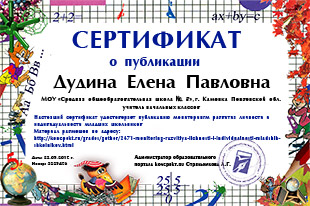Статья "Веб квест в преподавании английского языка"
Interactive learning technologies are the most effective, contributing to high personal involvement in learning, quick access to information and increasing students' cognitive motivation.
In this regard, the problem of improving the process of organizing educational and cognitive activity of students in the process of their education at school is acute.
The decisive role in improving the efficiency of the educational process belongs to the use of modern technologies within the educational process. Currently, it is impossible to imagine a modern educational process without the use of Internet technologies.
One of the modern technologies is a web quest. This fact determines the relevance of the question.
The origin of the Web Quest
The concept of web quest was developed in the USA at the University of San Diego in 1990s by professor B. Dodge. Bernie Dodge developed a learning concept based on the format of online lessons, which, in his opinion, make the best use of class time, developing higher-level thinking skills.
Soon a report by Bernie Dodge on the topic "Some thoughts about Web Quests" followed. After that the scientific community began to actively use this methodology. The web quest portal of the University of San Diego contains methodological recommendations, numerous examples and templates that help teachers create a web quest on their own.
School developers and university teachers used the Web Quest page as a source of educational materials and ideas for their own classes. As Web Quest grew, the page developed links to Web Quests created around the world.
In web quests, the authors managed to combine the most effective educational practices into one holistic system of student activity.
The concept of a web quest
A Web Quest is an inquiry-oriented lesson format in which most or all the information that learners work with comes from the web. These can be created using various programs, including a simple word processing document that includes links to websites
Web Quest can be used in one lesson, or perhaps it will be a series of lessons combined with one topic. Building a Web Quest can involve group work, with a division of labor among students who take on specific roles or assignments. Assignments, in turn, are built around resources previously selected by the teacher. Thus, students spend their time using information rather than searching for it.
Web Quest gives students specific tasks that they independently perform and are responsible for them. The Web Quest format is best suited for less well-defined topics that open up creative possibilities, and problems with multiple possible solutions.
Web Quests are based on the ideas of knowledge search and constructivism. Web Quests also include collaborative learning, as students work on projects in groups. These concepts can play a role in learning. Web Quest can also help students meet standards focused on critical thinking and analysis skills, and can be especially useful for social studies and science.
The web quest structure consists of several sections: introduction, tasks, process, resources, evaluation.
The introduction section provides background information, as well as a motivational component for students to choose roles for the game. It also provides an overview of learning objectives for students. The purpose of the introduction is to make activity desirable and fun for students.
The task is to formally describe what the students will do by the end of the Web Quest. First, the teacher finds resources for a specific topic on the Internet. Then, he develops an activity for students that includes information from various websites. This task should be feasible and interesting.
The process. This is a description of the steps that students must go through in completing the task, with links embedded in each step.
Resources. This section of Web Quest consists of a list of resources (bookmarks of websites) that your students will need to complete the assignment.
Evaluation. Each Web Quest should contain a section for evaluating students' work. Standards should be fair, clear, consistent and specific for the tasks set.
Conclusion. Credits. Copyright Recognition. Teacher Page. Information for the teacher.
The algorithm for composing a web quest
The process of creating of a Web Quest is not always linear, but there are certain steps that can be taken to create your own Web-Quest. Now there are special websites on the Internet for creating Web quests, where you can find templates for Web-Quest and detailed instructions on how to create them.
There is a list of such sites:
- Quizwhizzer.
- Learnis.
- Квестодел.
- Urban Quest.
- Surprize me.
- Genially.
- Webquest Generator.
It should be noted that the web quest can be issued both on paper and in electronic format.
Step 1: Define the topic. There are four conditions that the theme of your Web quest must meet:
- comply with the requirements of state standards for the content of educational programs;
- contain a task that will contribute to the development of a higher level of thinking of students;
- meaningfully replace or supplement the available materials on the topic of the lesson, the development of which you are not completely satisfied with on the part of the students;
- use the Internet effectively.
Step 2: Select a site that has a matrix (template) for creating a web quest.
Step 3: Come up with tasks. From the beginning, select the form in which the students will receive the task. There are several options:
- In the form of a presentation (e.g. PowerPoint program - extension .ppt) We place a picture on the slide and write one or two questions. So on each slide you can consider a specific topic.
- In the form of text (e.g. Word program - extension .doc). We place information with pictures and questions in the form of formatted text on an A4 or A3 sheet.
- Visual material. It looks like a set of pictures, photos, cartoons, (you can attach it as an archive extension.zip, since the size of applications is limited).
Step 4: Come up with an assessment system. The number of points awarded for a particular question.
Step 5: Find the sources of information that students will use to find answers.
Step 6: Having an approximate plan and basic information on the sheet, start creating a Web-Quest
Advantages of using a web quest
Web quest technology in teaching English allows you to:
- develop information skills;
- to form a positive emotional attitude to the process of cognition, to increase the motivation of learning, the quality of assimilation of knowledge on the subject under study;
- develop the creative potential of students;
- to form general skills of mastering the strategy of assimilation of educational material.
At the same time, the topics of web quests can be very diverse, problematic tasks may differ in the degree of complexity.
Advantages of this technology:
- While working on the study of a topic, the teacher uses extensive information from Internet resources on a specific topic.
- While working on the web quest, the student can choose the most convenient pace for him to complete the task, regardless of whether he is working on the web quest individually or in a team.
- The web quest provides an opportunity to search for additional information on the topic, however, within certain limits set by the teacher.



